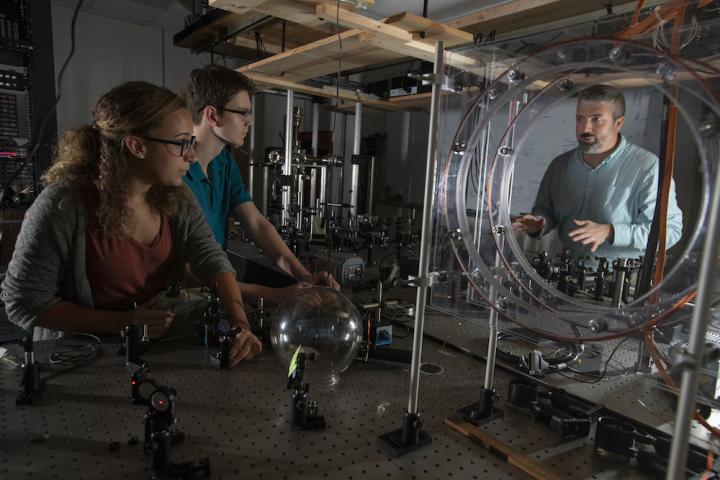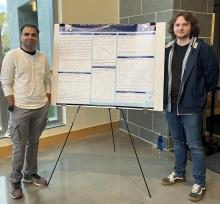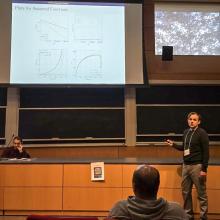
The Department of Physics at St. Mary’s College of Maryland received the Diversity and Inclusion Advocacy Recognition for its efforts to increase diversity and inclusivity in science during the all-virtual 2020 Frontiers in Optics + Laser Science APS/DLS (FiO + LS) Conference presented by the Optical Society of America on September 15, 2020.
“Nationally, there is a new awakening for the need for inclusive diversity, especially in the physical sciences. It is great to see our physics department gaining additional recognition for their sustained efforts in this important endeavor,” said President Tuajuanda C. Jordan.
The physics department was acknowledged “for making long-term changes that improve diversity, equity and inclusion in its operations and culture.”
“The physics department of St. Mary’s College is honored to receive this recognition from the Optical Society of America. It reflects on the efforts of every member of the department's faculty and staff, along with our students and alumni. This recognition encourages us to work even more for inclusion and equity, and we hope it provides encouragement for others, too. Ultimately, our goal is to create an environment in which all students and members of our community can achieve at the highest level,” said Josh Grossman, professor of physics.
According to OSA, the selection committee was enthusiastic about the department’s commitment to ensuring that all members of its physics and entire STEM community feel welcomed and are able to thrive. The department has achieved gender parity amongst its faculty and staff. The gender balance of its student population exceeds the national rate for the discipline. It reinforces these key values by including diversity and inclusion workshops and seminars as part of all courses in its curriculum.
“At St. Mary’s College of Maryland, diversity is an essential part of our mission. Our physics department continues to show a commitment not only to the College’s mission but to our core values in their work toward increasing diversity,” said Jordan.
Like other STEM programs at St. Mary’s College, the department offers an Emerging Scholars Program targeted at students from underrepresented groups. In the ESP, students build an identity as a physicist, along with a support network, by participating in challenging enrichment activities in a fun, cooperative setting. The physics department also participates in the American Physical Society Inclusion, Diversity, and Equity Alliance (APS-IDEA) via its own departmental action team of students, alumni, faculty, staff, and outside experts.
The recognition honors the steadfast commitment and achievements of OSA members, companies or institutions that proactively work to create a more diverse, equitable and inclusive optics and photonics community.
According to OSA, the scientific community benefits from the engagement of diverse voices to enhance scientific research and application. This recognition serves to acknowledge efforts of individuals and institutions who uphold these same values through community service, professional development, mentoring, trainings and resources.
In 2019, the St. Mary’s College physics department was featured in an article published by Physics Today, titled “A Physics Department Fosters an Inclusive Environment” describing how the faculty had introduced measures to prevent exclusionary and harassing behaviors toward women and minority students. In 2017, it received the American Physical Society’s Award for Improving Physics Education. Previously, the department was featured as a role model in the national report, “Phys21: Preparing Physics Students for 21st Century Careers.”
The OSA also recognized during the ceremony Arti Agrawal, associate professor of engineering and IT, University of Technology Sydney, Australia; and Jennifer Burris, chair of the department of physics and astronomy, Appalachian State University, North Carolina.
“The recipients of this recognition work tirelessly to ensure that the search for scientific discovery is informed by diverse perspectives and experiences,” said OSA CEO Elizabeth Rogan. “We should all be inspired by the accomplishments of these honorees who embody OSA’s core value of inclusivity by prioritizing diversity in optics and photonics.”
About the Optical Society of America
Founded in 1916, the Optical Society of America is the leading professional organization for scientists, engineers, students and business leaders who fuel discoveries, shape real-life applications and accelerate achievements in the science of light. Through world-renowned publications, meetings and membership initiatives, OSA provides quality research, inspired interactions and dedicated resources for its extensive global network of optics and photonics experts. For more information, visit osa.org.



